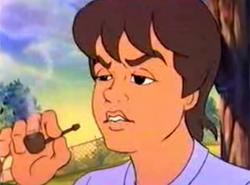The 10 Greatest Anti-Drug Cartoon Episodes
The TV cartoons of our childhood lived by a few simple rules: toy lines must be pushed, animation must be cheap, and, to keep the parents happy, lessons must be learned. And in Nancy Reagan?s America, there was no more important lesson for young viewers than the one about saying no to drugs. Nearly every cartoon in the nation dedicated an episode to exploring the evils of controlled substances, all overseen by producers who were likely doing blow off of Care Bears cels. Hey, it was the ?80s.
This made for some of the most hypocritical, heavy-handed moralizing ever animated, but there were deeper forces at work. For the stranger shows, it was a challenge to work cocaine symbolism into The Biskitts or Mighty Orbots. For the writers frustrated with the nobody-ever-dies precept of American cartoons, it was an opportunity to finally kill someone off. For kids, it was a chance to show mom and dad that those lousy Saturday-morning irritants were saving you from a life of shooting heroin or fencing stolen TVs. For us, it?s an excuse to recall the most memorable anti-drug cartoon episodes of the last 30 years and reflect on how little they actually taught us.
type="text/javascript">
10) He-Man: ?A Friend in Need?
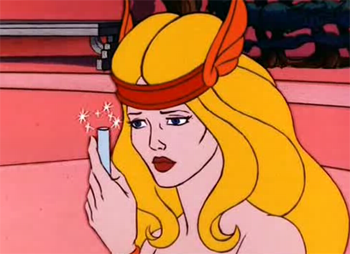
He-Man and the Masters of the Universe all but introduced cartoons to the practice of cramming values down kids? throats, as each episode ended with a character insufferably spelling out the lesson instilled by the preceding story. For the sharper viewers who made a game out of spotting the obvious themes, the episode ?A Friend in Need? threw them a softball. During a visit to the capital of Eternia, Teela?s timid friend Ileena finds herself wishing to be stronger and braver, and her habit of expressing her insecurities aloud draws the attention of her father?s worst enemy, a mincing wizard named Jarvan. Needlessly dabbling in cross-dressing, Jarvan posses as an old woman and gives Ileena a mysterious vial. While steroids might?ve served her better, the nameless concoction turns Ileena into a danger-loving party girl.
Online Videos by Veoh.com
As per the standard anti-drug credo, Ileena is soon betraying friends for her fix while Jarvan is threatening to destroy the kingdom with a shrink ray. He?s undone by the Eternian version of a drug sting, with He-Man playing the role of the pun-spouting, overly smug Narc.
The Drug: Some form of magic cocaine, though He-Man later tells us that there aren?t any ?magic drugs.? This raises the question of just what the hell Ileena was on.
The Lesson: Taking drugs? That?s for losers! Using drugs in a ruse to trap an evil sorcerer? That?s for heroes like He-Man!
9) Thundercats: ?Crystal Canyon?
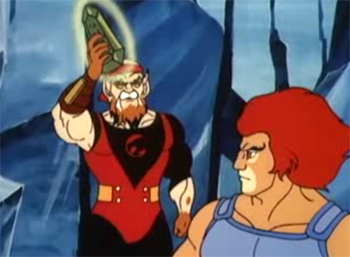
Like most animated TV fare in the ?80s, Thundercats was a bit too far from real life to feature genuine marijuana and coke. When the obligatory anti-drug episode rolled around, it fell to a restorative crystal to get one of the Thundercats addicted. Upon crashing in some glittering caverns, Lion-O, Tygra, Snarf, and the blind, aged Lynx-O discover a green gem that heals their injuries (though not Lynx-O?s blindness). Tygra, best known as the Thundercats figure you got when Toys ?R? Us was all out of Lion-Os, grows a bit too fond of the magical, energy-giving keystone. It?s not long before he?s running around feverishly, challenging Lion-O?s alpha-male status, and shunning Snarf?s attempts to feed him. We can?t blame him for the last of these.
Tygra is eventually robbed of his crystallized meth by Alluro, a pink second-stringer in the Thundercats villain ranks. Alluro becomes just as hooked on the keystone, using its power to capture Lion-O and Lynx-O while Tygra trembles in withdrawal. Fortunately, Lion-O?s sword signal snaps Tygra out of it and spurs him to fight Alluro. The crystal?s knocked into a bottomless gorge, and Alluro follows it to his defeat. Tygra declines to help his stranded foe, and instead reflects that he almost met the same fate.
The Drug: The Keystone seems to be some kind of amphetamine, though Lion-O?s sword is apparently an even more effective upper.
The Lesson: Drug addiction is a horrible thing, but not when it happens to ugly people who you hate.
8) C.O.P.S.: “The Case of the Lowest Crime?
One would expect C.O.P.S. to come down on drugs harder than any other ?80s cartoon, since the show?s good guys were rhyme-spouting police officers of the future. In the episode focusing on ?the lowest crime,? however, it?s the show?s villains who get the most screen time to take a firm, drug-denouncing stand against Crystal Twist, a sparkling new drug working its way through Empire City. Addictem, the haggard, white-haired dealer who?s apparently supplying an entire metropolitan area, offers to cut the show?s normally corrupt head villain, Big Boss, in on the Crystal Twist business. A furious Big Boss has Addictem thrown out and proclaims that ?Drugs KILL!? Apparently city-controlling gangsters never do.
Big Boss makes his annoying underlings swear they?ll never touch drugs, which sets up a scene where his nephew Berserko accidentally falls into Addictem?s next shipment of Crystal Twist. Shocked by the effects of drugs, Big Boss and his cronies throw in with the C.O.P.S. forces. Their mutual sweep of the city chases Addictem to a local hospital, where the recovered Berserko grabs him and threatens to ?thank him? in private. With that, the city is instantly free of drugs. The police close the case with a stern warning and a photo of a horrified Addictem, who?s clearly contemplating all the ?thanks? a scrawny guy like him will get in prison.
The Drug: Crystal Twist is evidently meth, though it?s absorbed instantly through the skin and shaped like giant Lisa Frank earrings.
The Lesson: Don?t do drugs, because other forms of crime are more fun and less harmful. Selling drugs is implicitly lower than rape, murder, or blowing up the sun.
7) The Smurfs: ?The Lure of the Orb?
There?s something vaguely disingenuous about the Smurfs denouncing drugs. Sure, it?s not as two-faced as the episode of A Pup Named Scooby Doo where the infamous stoner dog exclaims ?Drugs? Yecch!?, but the Smurfs did live in mushrooms and, in their first movie, were met by humans who?d been hypnotized into a peyote-like fever dream. Yet the Smurfs were still cartoon characters, and they had to take a stand on the nation?s drug issue.
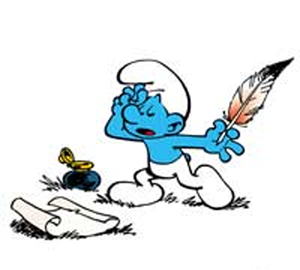
We would?ve pegged Jokey Smurf as the resident druggie, but it?s the underused Poet Smurf who shows kids the dangers of addiction. With his creativity running dry, Poet finds a muse in a mysterious fairy who offers him a magic orb. The drug stand-in gives Poet renewed energy, and he shares it with other occupationally classified Smurfs. Yet the orb leaves them spent and depressed, so Hefty Smurf, possibly in the grip of roid rage, destroys it. Yes, it?s just like the time your dad smashed that flute-thing he found in your big brother?s room, kids.
Undaunted, Poet and some of the more addicted Smurfs seek out the fairy and end up becoming her servants in exchange for a taste of another orb. Everything?s set to rights by the end of the tale, though it would?ve been easier to do an anti-drug episode where the Smurfs just got high by eating their own roofs.
The Drug: The orb is probably the least drug-like of any cartoon cocaine. Granted, any real drugs in the Smurfs universe were likely dubbed ?smurf? and smurf.?
The Lesson: It?s always the artsy types who get into drugs and drag their friends down with them. That?s why you should major in accounting when you get to college.
6) Galaxy High: ?The Brain Blaster?
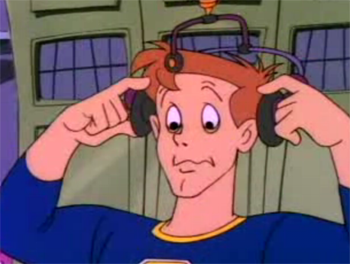
There was no way Galaxy High could dodge an anti-drug segment. The show was set at an intergalactic high school, after all, and one of the two human kids there was Doyle, a dense and impressionable jock. Desperately trying to get his grades up in time for a psyche-hockey tournament, Doyle turns to a Brain Blaster headset supplied by an oily, trench-coat-wearing pusher. By frying his neurons, Doyle becomes a brilliant, energetic kid, passing tests and drawing concern from his friends, including fellow human student Aimee and at least one alien voiced by Nancy ?Bart Simpson? Cartwright.
Yet Doyle?s in over his head, and he starts ripping off other students to pay his dealer?s increasing brain-blast rates. After he?s caught buying supplies in the Galaxy High equivalent of inner-city projects, he?s pulled back from the brink and thrust into the psyche-hockey tournament without any chemical help. Doyle loses, but both his opponent and the school?s dealer are both arrested for trafficking in brain-blaster narcotics.
We may never know if it was the show?s slightly smarter-than-average approach to the subject or its surprisingly decent animation that impressed someone, but either way, Galaxy High?s just-say-no episode earned a Humanitas nomination. That?s more than you can say for the Smurfs.
The Drug: Brain-blasting sounds quite useful, since it allows users to infuse their minds with a celebrity?s knowledge. And the government over-regulated it. Bastards.
The Lesson: You can abuse drugs as long as you give them up right before you get caught. And as long as you?re white.
—-
5) Captain Planet: ?Mind Pollution?
Had it come from a more subtle time, Captain Planet would be a full-blown parody of preachy, celebrity-endorsed environmentalism. In the irony-free world of early 1990s TV, however, it was just Ted Turner?s pet project, and no one was going to tell a broadcasting magnate that it was a bit excessive to have five multi-ethnic kids fighting pollution with the help of a green-haired, mullet-sporting superhero. Captain Planet was at its most ham-fisted in its anti-drug showcase, ?Mind Pollution.?
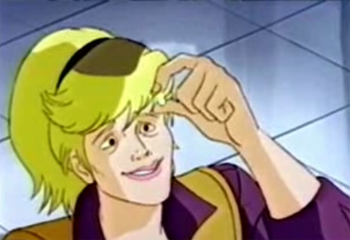
During a Planeteer jaunt to Washington D.C., Linka, the blondest and most Russian of the Planeteers, visits her cousin Boris. As shown by his red eyes, evasive behavior and inability to ride a bicycle, Boris has recently been ensnared by a new designer drug called ?Bliss? and distributed by recurring Captain Planet polluter Verminous Skumm. At Skumm?s insistence, Boris gets Linka hooked (above) and, in record time, the American capital is overrun by zombie-like Bliss addicts. Cornered in a maze of poorly researched local landmarks, the Planeteers fend off a drug-crazed horde while trying to sober up Linka. It?s not until Boris dies in front of her that she comes around. In the end, Skumm accidentally gets hooked on his own supply, and the rampaging addicts are free to recover, with Linka?s cousin becoming the only apparent casualty of city-wide rioting.
The Drug: Bliss induces euphoria, and its users adopt zombie-like behavior, play in traffic, and grow huge, badly drawn blotches everywhere.
The Lesson: Drug dealers can be identified by their bare feet and ratlike features. Also, the American Planeteer guy totally wants the Russian Planeteer girl.
4) Jem: ?Alone Again?
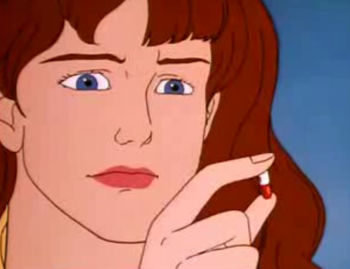
Sunbow?s cartoons often didn?t bother with anti-drug overtures, especially not when the shows themselves were a bit unrealistic. That?s why the Transformers never got strung out on Energon smack and the My Little Ponies were never enslaved in some centaur overlord?s opium refinery. Jem, by virtue of not having giant robots that turned into tape decks, was the studio?s most down-to-earth cartoon in the ?80s, and so it was duty-bound to say something about drugs.
?Alone Again? introduces Laura, a new arrival at the orphanage run by Jerrica/Jem and the rest of her day-glo Debbie Gibson cover band. Instantly depressed that she doesn?t have a puffed neon hairstyle, Laura tries to concentrate on her whiny songwriting, but the pressure leads her into the arms of a dashing young dealer who hangs out at kindergarten playgrounds. He offers Laura some pills that briefly perk up her guitar skills. Then she hallucinates her lunch box turning into a bird and tries to jump off the roof. She?s rescued by Jerrica, who figures things out a little too quickly. Since when do rock stars know anything about drugs?
By the episode?s closing number, Laura?s learned some important things: drugs are bad, having low self-esteem is also bad, and boys who wear leather jackets and hang out in arcades are really bad, even if they hit on you. We?re then treated to a Jem music video that shows Laura meditating and floating through space. Yes, she?s clearly off the drugs. Clearly.
The Drug: Some LSD relative, judging by Laura?s freakout.
The Lesson: Never trip alone.
3) G.I. Joe: ?The Greatest Evil?
G.I. Joe?s producers at Sunbow did a nation of children a favor by confining their lectures about safety and nutrition to public-service shorts at the end of each episode. Thanks to them, kids knew exactly when they could change the channel or run to the kitchen without missing the part where Snake Eyes fought Storm Shadow or the Baroness married Destro. But the Sunbow studios and G.I. Joe parted ways in 1988, and the show?s new handlers at DIC and Hasbro decided that simple PSAs weren?t enough when it came to teaching kids about drugs.
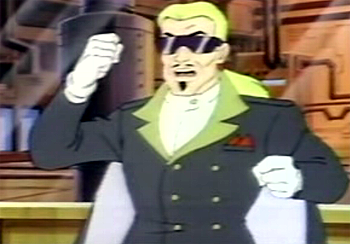
In the G.I. Joe universe, drugs were far too horrible for even the forces of Cobra to meddle with, so DIC devised the Headman (above), a new villain with his own private mercenary force and a stockpile of a new drug called Spark. The Headman?s troops took over entire city blocks, even introducing a Cobra trooper?s sister and the G.I. Joe forces? Lt. Falcon to the enticing slow death of Spark.
Despite having a voice like Frank Nelson (or The Simpsons? ?Yeeeeessssssss? Guy) and a wardrobe that would?ve been laughed out of a 1991 Vanilla Ice concert, the Headman was so drug-dealingly evil that G.I. Joe and Cobra joined up to destroy his empire of human filth. In defeat, he overdosed on his own Spark and was crushed by his collapsing fortress, becoming the only obvious death in the entire G.I. Joe animated canon.
The Drug: Like other made-up cartoon drugs, Spark is a lot like cocaine, except its users run through the effects in about twenty minutes.
The Lesson: Do drugs, and you can be saved. Sell them, and you?re worse than a ruthless terrorist organization determined to rule the world.
2) Bravestarr: ?The Price?
As Filmation?s less successful follow-up to He-Man, Bravestarr made the most of loosening cartoon standards in the latter half of the 1980s. If shows like The Inhumanoids could have gruesome monster deaths wall to wall, Bravestarr was allowed to and disintegrate an alligator-man just to reveal to kids the importance of keeping their tempers or brushing their teeth or whatever.
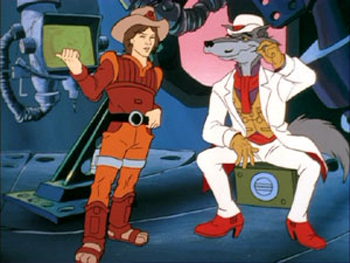
So the writers had no reservations about offing the requisite druggie when Bravestarr?s anti-drug episode rolled around. In Bravestarr?s futuristic Western world of New Texas, a drug known as Spin is ravaging Marshall Bravestarr?s town, and its primary seller, a wolf man dressed in the height of ?70s pimp fashion, offers his wares to two boys, Brad and Jay. Brad declines, but Jay has obviously realized that drugs are the best thing he?ll ever find on a bleak, ugly desert planet full of squeally-voiced Ewoks and redneck horse-people. As Jay spirals down into addiction, Brad dithers about narcing on his friend. He eventually tells Bravestarr and his horse-man deputy, who are busy shutting down a poorly hidden Spin factory. Our heroes race to Jay?s home?but he?s dead. From drugs.
The Drug: Spin rapidly turns a rural community into a land of wasted, hollow-eyed freaks, eerily foreshadowing the modern meth problem.
The Lesson: The government?s more concerned with busting up the drug network than treating addicts. Oh, and you should rat on your friends the second you see them so much as talking about drugs. You?ll be the coolest kid ever.
1) Cartoon All-Stars to the Rescue
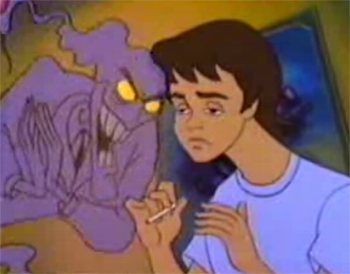
As the ?80s drew to a close, cartoon producers realized something: despite their hard-hitting stance against drugs, the teenagers of America were still using them. Clearly, it wasn?t enough that the Smurfs and the Ninja Turtles were each telling kids to say no. They all had to do it at once. Thus, Cartoon All-Stars to the Rescue was born, roping kids in with a never-before-seen and never-since-equaled crossover among Duck Tales, Alf, Garfield, Alvin & The Chipmunks, Looney Tunes, Winnie the Pooh, The Ninja Turtles (well, they were only budgeted for one), Smurfs, Muppet Babies, and just about every other cartoon that people still remembered by 1990.
Our cautionary tale begins with a teenager named Michael swiping his sister Sally?s piggy bank to score some drug money. In response, cartoon characters crawl out of Sally?s records, posters, and furniture to figure out that her brother?s using marijuana. God help him.
Michael, meanwhile, gets high with friends at that den of teenage vice, the video arcade, and his addiction comes to life as Smoke, a talking, suit-wearing spirit played by a slumming George C. Scott. As this most special of very special episodes wears on, Michael is confronted by various animated celebrities. Bugs Bunny hectors him about the health risks of dope, Michaelangelo (yes, the Ninja Turtle that gobbled pizza and always sounded baked) drags him into the sewers for a mutant-to-man talk about weed, and Kermit the Frog, Gonzo, and Miss Piggy use a roller coaster ride to show Michael the effects of habitual drug use. Because teenagers hate roller coasters, you know. When Michael isn?t completely won over, the cast corners him and delivers their ace in the hole: a song.
Eventually, Michael is convinced that drugs are bad and heads home in time to see the impressionable Sally being corrupted by Smoke, prompting Michael to throw the ghostly embodiment of drug use out a window. Michael then promises to kick his habit, and the cartoon characters retreat into their home dimension through a poster, certain that America?s drug problem is solved once and for all.
Cartoon All-Stars To the Rescue is easily the high point of animated anti-drug sermonizing, though most of the kids who tuned in were likely let down that the characters spent more time ranting about potheads than interacting with each other (at least Alf threatens to eat Garfield). The special even made kids sit through an introduction narrated by George and Barbara Bush, even when it might?ve been more effective to have their son talk candidly about his coke-snorting days at Yale.
The Drugs: All real, from weed to crack, the latter of which is identified by Michael as ?serious stuff.?
The Lesson: Just one joint and you?ll be constantly hassled by some of the shrillest, most annoying cartoon characters the 1980s had to offer.

